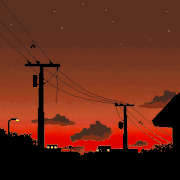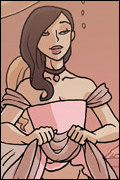|
Black August posted:Marc is opposed by Mammon, the Prince of Greed, who you can reasonably assume encompasses the concept of Capitalism from the Infernal side, and also likely has a demon devoted to the Word. Notably, Mammon is not doing well against Marc. If anything, Marc isn't really concerned with Trade as a money thing like Mammon is with Greed, he's concerned with how these systems that humans made can benefit mankind and help sway the War for them and a better future. Trade as an angelic word seems to have a strong association with the concept of win-win interactions (the infernal version would look a lot more like Lilith's constant geas-swapping). So that no matter what you try to do to Marc, he always finds a way to come out a little bit more ahead. You can't really actively oppose him, you can only just starve him out and wait for him to make a stupid mistake.
|
|
|
|

|
| # ? Apr 19, 2024 09:27 |
|
potatocubed posted:I've been meaning to do this for ages, and now I've found the time. This game makes me think of Exalted, but with clearer themes and better mechanical integration. Too bad the book is even more of a mess than the Ex3 backer copies; it's a great concept so far. Love the idea of Ownership.
|
|
|
|
snip
potatocubed fucked around with this message at 10:04 on Jan 10, 2019 |
|
|
|
Corporeal Player's Guide: Rogue, Fighter, Wizard Not all humans who are Symphonically aware pick a side. Some work only for themselves, or are unaware of the War. It's hard to stay uninvolved, given all the people that want to recruit or neutralize Soldiers, but a few humans manage independence. These are known as rogues. The most ocmmo ntype of rogue is the 'Gray Soldier' - a former Hellsworn that has decided to abandon serving demons but is not seeking salvation. Sometimes they want redemptiob ut have no idea how to start, or are too afraid. Gray Soldiers are treatd as Renegades - demons hunt them down, and angels usually treat them as hostile. A rare few Gray Soldiers who know about infernal hierarchies and have some contacts among angels (and often favors among Outcasts, Renegades and Free Lilim) know enough to trade information and keep ahead of the Game and their old masters. If they can keep their head down and avoid attention, they may remain alive and free...but unless they redeem themselves, they remain damned. More rarely, Soldiers of God also abandon the cause to strike out on their own. If they don't defect to Hell, they may be hunted or left in peace depending on who they served, so long as they stay out of the War, which isn't easy when everyone else that knows about them wants them back in. Some rogues are secret Soldiers - initiated by groups other than angels, demons or ethereals. They aren't really independent, but they work for independents. Outcasts and Renegades are the most common recruiters of secret Soldiers, and they are also happy to recruit Gray Soldiers. Sometimes, they are daring and lucky enough to recruit a fresh Soldier with no knowledgeo f the War. They may reveal all or nothing as they like, and their Soldiers can be trusted allies or abused minions. The Host and the Game both either try to kill or recruit secret Soldiers, based on a combination of their usefulness, their knowledge and their past actions. Sorcerers have plent yof need for Soldier bodyguards and assistants, and are some of the few humans who know enough to recruit Soldiers. They also happily recruit Gray Soldiers, and it can be either well-paid work or near slavery, depending on the employer. Soldiers who work for sorceers sometimes become sorcerers themselves, if they have the Will and inclination. Munanes who discover the Symphony but do not understand it also happen. Some paranormal researchers occasionally find 6-Force humans, and thus can recruit their own Soldiers. Other groups, from cops to corporations to criminals, may hire someone with supernatural powers and not care about the details. The most unpredictable rogues are the ones who are 6 Forces through their own doing and manage to avoid discovery. They hear Disturbance but don't know why, and they learn to control their Essence and become very lucky. They rarely learn Songs, as they have no teachers, but sometimes they find artifacts. If they learn about the War, they may try to stay out of it and hide. Many of them are Children of the Grigori. That siad, it is possible to learn Songs without being taught. Long exposure or accidentally duplicating hte performance ritual might allow a rogue to learno n their own. With no one to teach the truth, these rogues often believe they have spiritual, magic or psychic powers. They may form cults, and anyone who uses these 'spells' or 'powers' too often will eventually get noticed, but because celestials usually dismiss human claims to supernatural power as charlatans and fakes, someon who is lucky and discreet can remain hidden. So, prophets. Gabriel is known to channel God directly, speaking His words through her madness and seeing Truths even the Seraphim cannot. Occasionally a mortal can do the same thing. These mortals, able to receive divine visions, are known as prophets. No one knows what triggers the gift. Some believe they're all Children of the Grigori, but there's no evidence for that. All prophets have the potential for at least 6 Forces, but need not fulfill that potential. Sometimes they are Symphonically aware, but often they are not. No attempt ot detect or create prophets has ever worked, and there is no noticeable difference in their configuration of Forces from normal humans, so only a Seraph can be totally sure a prophet is truly receiving visions. Many prophets go insane, and those that don't usually keep silent about their visions for fear others will think them insane. They are like any other human in most ways - their Divine gift does not guarantee them a spot in Heaven, and some prophets use their powers selfishly or ignore them. Prophets can become Soldiers, and they are treasured and protected by both sides. Angels see them as blessed, and demons as a source of strategic data from the enemy. Prophets receive visions frm the Divine. The nature and frequency of these visions is random and up to the GM entirely, but all visions they receive are in some sense true. Some prophets see the future, while others see visions of the past. Others see events going on elsewhere but in the present time, on or off Earth. Visions may be literal and clear, or symbolic and confused. Some prophets receive only a few visions in their life, others see visions every day or even every moment. Some learn to summon and control the visions with a Perception roll, CD determining clarity of vision, but others cannot manage to control the power. Their visions are never false, however. This power is very potent, and it exceeds an angel's resonance in scope. As far as anyone knows, only Gabriel has ever been a non-human prophet. Lucifer cannot create prophets, but he can make false prophets, and occasionally does so to make people and celestials distrust prophetic visions. False prophets receive false visions, generated from Lucifer's imagination. These visions can be of the past, present and future, and may come in any form. Sometimes they will be accurate - Lucifer is, after all, a Balseraph - anything he sends is what he believes to be true at the time, and sometimes it is actually true, or he makes it true. A Seraph can tell the difference between a true and a false prophet...but only on a CD 6, and only if resonating a false prophecy. Lucifer chooses people to be false prophets at whim. They always have 6 potential Forces, and beyond that, some are good people and some mad or evil. False prophets, like true ones, retain their free will and can go to Hell or Heaven. Lucifer my revoke their visions at any time. Sorcerers, of coruse, are humans that learn sorcery. They have many, many motives and can be problems ofr anyone. A sorcerous cabal is also a good foe for a grou pof Soldiers. Sorcerers sometimes work for demons, and they can be fun PCs in a human or mixed game. They tend to the mysterious and their powers are subtle and secret. They tend to be secretive in general, and demons spread rumors and disinformation about them to confuse people. Non-sorcerers should never really be sure how sorcery works or what a sorcerer can do. Even sorcerers rarely do more than scratch the surface of the art. All sorcerers are Symphonically aware, but are also often ignorant of the War. They hear Disturbamces, which they refer to as the Cacophany, but rarely know why. Some summon demons or spirits, but come up with their own classifications for these beings. Heaven and Hell rarely fit their worldview except in the abstract. Sorcerers are more often than not pawns of Hell. It is possible for them to serve as Soldiers, but rare - they tend to be too willful and focused on their own desires to work for more than a contract basis. Undead canbe sorcerers, and often are. It is theoretically possible for a Saint to be a sorcerer, but is not known to have ever happened. Then we get a general rehash of the other sorcery information.    We do, however, get the first explanation of white sorcery. See, sorcery is inherently selfish. You don't have to be evil, but every sorcerer must believe in their core that they have the right to impose their will on the universe and bend it to their ends. There are no humble, selfless sorcerers. That and the fact thatm ost gain their power from infernal pacts or bargaining with spirits or demons for power means that most sorcerers work for Hell. However, a rare few manage to act selflessly enough to avoid damnation. Doing sorcery does not automatically seal your fate, after all, and those that stick to purely benign work can reincarnate, or even achieve their destinies. Hatiphas despises them, but above all, she hates the 'white sorcerers' who work for Heaven. I nfact, she denies that they exist at all, but it's best not to mention Merlin or Solomon around her. White sorcerers must fight a constant battle with their own selfishness and the lure of knowledge and power in exchange for evil acts. Plus, they need to hide - demons of Fate and the Game will quickly try to kill any white sorcerer they find, and Dominic isn't that much more tolerant. Perhaps the real reason, however, that demons mount such an extreme response is that some white sorcerers are rumored to be redeemed diabolical sorcerers, who gained their power via infernal pact yet escaped their fate by serving Heaven. Hatiphas denies that this is even possible, of course, but they remain one of her greatest problems, in part because she refuses to stop claiming white sorcerers don't exist. Crossbreeds are a form of human that do not get wide discussion by celestials. With the use of the Songs of Fruition, ethereals and celestials can have children with mortals. These crossbreeds are mortal, but often have unusual abilities, and they include the Children of the Grigori. Both Dominic and Asmodeus forbid breeding with mortals. Ethereals that seek to have children this way are ruthlessly hunted, and celestials must face Judgment or the Game. The children's fate depends on who finds them. Angelos, even Judges, do not blame the children for their parents' sin, though they will be watched closely. Demons tend to see crossbreeds as a resource to be recruited or destroyed. Nephilim and Gorgons are another matter. Angels are ordered to report them to Judges, who will do what must be done. Demons tend to kill them on sight unless they seem recruitable. In the old days, the pagan gods had chidlren with their worshippers fairly often. These days, the Host pesecutes any who even visit Earth, and espercially those that create offspring, but it still happens sometimes. Children of ethereals are outwardly human. There's no clear rules to how they will turn out, but some traits do manifest more often than not. First, many have extra potential for Forces, and a higher tendency to manifest them, especially in events triggered in the Marches. They are usually lucid dreamers and, if 6+ Forces, tend to become Symphonically aware. It is rumored that some have been born with a natural Ethereal Connection, but celestials insist this only happens when given by a pagan god. If an ethereal knows about its children, it will usually take an interest, and some are genuinely caring parents, while others see their offspring as resources. Either way, they often teach their children Songs or make them Dream Soldiers or sorcerers. Regardless of potential, however, ethereal crossbreeds do not breed true - it ends in one generation. The children of these crossbreeds are no more likely than any human to haveu nusual abilities. One third of all ethereal crossbreeds, however, are Gorgons. They are very rare, and if they are not born deformed, they usually become so later n life. Life expectancy is rarely high, even today. Gorgons are not actually monsters, however. They are exceptional humans who are physically and mentally twisted by their parentage. Mental defects often do make them malevolent, but even more often, that malevolence is due to mortal and celestial persecution. All Gorgons have at least 6 potential Forces and almost always reach that potential early. When they acquire the 6th Force, they automatically become Symphonically aware, but also develop Corporeal, EThereal and Celestial disadvasntages equal to their Forces in each realm, which can be openly supernatural. More often than not, this results in a psychotic abomination that is quickly put down, but some do survive. Sometimes, their disadvantages are even invisible and, even more rarely, they can live relatively benign existences. They do receive character points for their disadvantages and can purchase additional ones. Like normal ethereal crossbreeds, they often have an affinity for the ethereal realm and can learn Songs or sorcery.  Celestials, too, can create half-human children by the Songs of Fruition. This is forbidden, of course, but it does happen. Most celestial crossbreeds are just mortal humans with a high incidence of extra Force potential, and they are often drawn into the War by their parentage. Many have the Blessed advantage. Like ethereal crossbreeds, their children do not inherit any greater likelihood of extra Forces as far as anyone can tell, or any special abilities. (Note that a Kyriotate or other celestial possessing a human and having sex does not produce a crossbreed.) Like ethereals, however, celestials can also spawn monsters. These are called Nephilim, and most of them descend from Grigori, due to the strict rules on celestia lprocreation. Any angel who discovers a Nephalim must report them to the Inquisition and may not interact with them under celestial law. When investigating Nephilim, angeles always use the Celestial Song of Affintiy to hunt down and kill the celestial parent, which dissuades most demons from trying to make them. Nephilim are identical to Gorgons in all ways. One note, though - a Nephilim that goes to Heaven never becomes a Bodhisattva. They immediately ascend to the Higher Heavens. Nephilim that go to Hell can be found, but there are non in Heaven. Some angels believe they actually disband, and that Heaven is forever barred to them. Beyond this, there is no actualy difference between celestial crossbreeds and the Children of the Grigori, save that Dominic actively suppresses all discussion of Grigori and their offspring even more than normal. Next time: Immortals
|
|
|
|
Poor Grigori. They were a neat concept, though subject to the usual 'super special unique race buy the book' syndrome typical to the era. But that was thankfully nipped right in the bud since the planned Grigori book never ever took off, and the only material about them is bits in some books and the usual fan apocrypha. I got to read and roleplay some of the material about them, but they're honestly not that special, which is great, just a fun background element to the history of the setting, and a potential plot hook, especially since there's the Archangel of Song still on Earth. Gameplay wise they're dirt simple. They don't have bombastic powers, they don't shake the earth or break the system, they're just giant dudes who are basically Human -> Crossbreed -> Grigori -> Mercurian in terms of how close to humans they are on the divinity ladder. They can detect disturbance real good, the Symphony ignores them as basically human by giving them insane bonuses to Roles, and they get dissonance for not responding to disturbances, since, well, they're the Watchers and God made them to flush demons out. They can Fall, too. They become Dark Grigori, Skulkers, and can blank disturbance out, making them ABSURDLY hard to find, which is why their existence is summed up by a one-line sentence in GURPS In Nomine. Politically speaking though they're a rough draft mess that leaves it up to the GM to iron through. Default assumption is "Well why the hell would God gift an entire 8th Choir who then hosed around and He let get mass-banned by a blood-frothing Eli holding a shotgun and a nervous Dominic, well God knows it was probably on purpose for some inscrutable world-saving reason thousands of years down the road" I played a Grigori of Judgment who was good at hiding in trash cans and was pathetically happy when some big honking incident happened and he was given a chance to serve Dominic again as an Outcast on extreme probation. It was fun.
|
|
|
|
The defining quote for my next Night's Black Agents game: "I don't know who you are. I don't know what you want. If you are looking for ransom, I can tell you I don't have money. But what I do have are a very particular set of skills, skills I have acquired over a very long career. Skills that make me a nightmare for creatures like you. If you let Bella Swan go now, that'll be the end of it. I will not look for you, I will not pursue you. But if you don't, I will look for you, I will find you, and I will kill you."
|
|
|
|
Simian_Prime posted:The defining quote for my next Night's Black Agents game: When does the recruitment thread go up?
|
|
|
|
Guess what's back like a bad penny? If you have no idea what it is I'm talking about (and oh my god the last time I posted anything about this was August 2014, ugggggh) please go check out the Inklesspen archives. Unhallowed Metropolis is the core game and Unhallowed Necropolis is the expansion book.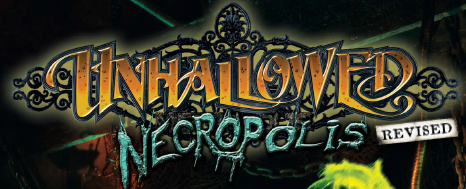 CHAPTER TWO PART ONE: Mysteria in Vitro Metropolis had eight character classes: Aristocrat, Criminal, Deathwatch Soldier, Detective, Dhampir Vampire Hunter, Doctor, Mourner, Undertaker. Necropolis adds five more classes and they all have to do with the supernormal and the spiritual: the Alienist, the Exorcist, the Medium, the Parapsychologist and the Psychic. 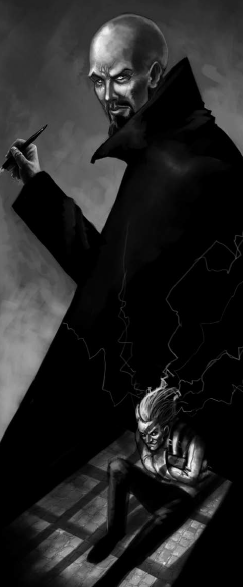 ALIENIST: Alienists are therapists, psychologists, psychiatrist, shrinks, head-doctors and more. While the plain, vanilla Doctor of Metropolis is a master of all sciences, the Alienist focuses on exploring the realms of the mind. Alienists play a wide role in Neo-Victorian society: they help the police on cases by discerning the pathology of the criminal mind, they are residents at private clinics and public hospitals and they study psychics. Of course, you're clearly playing the kind of Action Psychiatrist who kicks rear end for money if you're making an Alienist PC (or you're going to get up to some abominable shenanigans because of your Corruption). Alienists get the feature of MEDICAL AUTHORITY. Fill out the right paperwork at a sanitarium you're affiliated with and they will commit someone on your behalf. After a minimum stay of three days, the Alienist or the person responsible for the case will decide if the patient must stay committed and for how much longer. I honestly don't see much use for this specific function of the feature: you are cautioned not to abuse your powers lest they get taken away or a patient decides to get revenge on you, but this is still a pretty good way to just brute-force your way past a NPC or stonewall an enemy. They also get the feature of PSYCHOLOGIST: for every point in the skill Psychology, the Alienist gets to pick a bonus from the following list.
Thoughts on the Alienist: they seem to be built for two different roles. On the positive side, the Alienist is a steady force that helps keep the group stable and helps with investigation and psychics. On the negative side, it's really easy to turn your character into a morally repugnant person up to Abominable Shenanigans with their free drugs, brain surgery, ability to commit people and be in charge of their case. This is barely considering the madman they keep chained up in the coat closet. 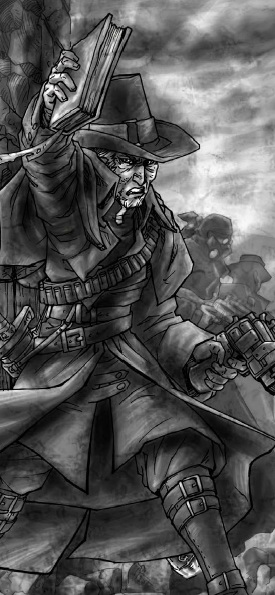 EXORCIST: Suffer not a ghost to live. Exorcists are folks with True Belief and force of will to fight back the forces of darkness. It's commonly believed that their power stems from their will and has nothing to do with actual divine manifestation. You end up with a lot of cultists and cranks picking up a book and a gun protecting the streets while Exorcists of major churches are held in good societal standing. Just pick a religion (or make your own beliefs) and figure out how your PC expresses their faith. Exorcists get a few different features. First, there's CRISIS OF FAITH. If your highest Corruption track is greater than your Will stat, you lose access to Compel, Lay to Rest and Deliverance. The Exorcist must redeem themselves to get the powers back. In the realm of class benefits there's COMPEL, which allows the Exorcist to make a Will roll against a spirit in their presence. If they win, the spirit is forced to tell the truth as long as it's near the Exorcist. This comes with a major dick move: the GM isn't supposed to tell the Exorcist if they succeeded the roll. LAY TO REST takes 10 minutes of concentration against a targeted spirit (which can retaliate) and make a Will roll. Succeed and you reduce the Spirits Will by 1. Reducing the score to 0 puts the spirit down for good, so you keep making rolls as your buddies help keep the ghost at bay. DELIVERANCE gives the Exorcist the ability to exorcise spirits from people or places by focusing for 5 minutes and making a Will roll against the spirit. Succeed and the spirit is ejected for 1d5 hours. You can follow up by sanctifying the area/person for a half hour to prevent the spirit from returning for 1d5 days. Finally, no fear rolls due to ghosts and stuff. Exorcists get extra powers from ranks in their Theology skill, one per level.
The Exorcist starts with the Faith quality (+1 to resist fear and exhaustion, meh) and Resolve quality (failing Fear saves only leaves you shaken, complete non-issue with some of these other abilities). They start with Concentration 2 and Theology 2 and can pick five of the following skills to start with: Etiquette 2, History 2, Melee Weapon 2, Parapsychology 2, Performance 2, Pistol 2, Psychology 2, Rifle 2, Thanatology 2, Torture 2, Unarmed Combat 2. Exorcists begin with the trappings of their faith and a good respirator. They start with vanilla lodgings at a boarding house or rectory, better or worse depending on if they adjust their Wealth. They start with Wealth 4 and get 20 pounds to spend on things. They can only keep 5 for savings. Thoughts on the Exorcist: Deliciously imbalanced in the right hands. It does the heavy lifting way better than the Undertaker or Deathwatch Soldier could ever hope to dream of and it's no slouch against ghosts. The ability to substitute your good stat for your melee damage stat is completely bonkers and I have a feeling they did not playtest this idea in the slightest. You would be a kind of MAD class if not for the ability to easily game the system and start with Purity, Theologian, Sword of Righteousness, Force of Will and Inspiration. All you have to do is make sure you have a good Coordination stat to help your defense. Now let's be fair: if I wanted to play this kind of character, I would be playing Warhammer 40k. But it's incredibly tempting to roll up someone like this and run roughshod on all of the dangers of the world, belonging to the one man Church of None Of This Is Real. I'm gonna call this one here because I think it's a beautiful thought to end on. NEXT TIME: the Medium, the Parapsychologist and the Psychic. Vox Valentine fucked around with this message at 06:35 on Feb 23, 2016 |
|
|
|
Bill Webb's Book of Dirty Tricks Part 5: Wolf in Sheep's Clothing This is about tripping up your players by throwing threats at them that they will either not know about, or will underestimate Cursed Items quote:Cursed items are an old trick long used by GMs on poor, unsuspecting player characters. I am actually of the mind that this has often been done unfairly (you put on the necklace and die, no save), especially since most of the time the nature of the item is undetectable. The reasoning behind pulling a stunt like this is so that the players don't get complacent, and also to discourage them from putting on magic items as soon as they're acquired. To be fair, the author does say that "you put it on, and then you die"-type curses should be avoided, as the players cannot be taught a lesson if the item just straight up kills them. Rather, he suggests creating items are critically flawed in one way or another, such as: * A Berserking Sword that looks perfectly normal until you enter combat, at which point the wielding starts randomly attacking any and every living being within 60 feet * A Backbiter Spear that looks perfectly normal until it is either thrown or rolls a 1 during the melee attack. When either of those two happen, the wielder deals themselves twice the amount of damage that should have been dealt to the enemy. * Magical plate mail that falls to pieces when the wearer hits 5 HP or less * Magical weapons that heal certain types of monsters when it hits them (of course, you won't know this until that particular monster is hit and healed) * Magical potions that end suddenly or create delusional effects that aren't really there. "Flying is fun" * A potion of growth, except it doesn't include your equipment. You can also use this to "counterbalance" certain items: give the players a Wand of 12d6 Fireballs, except 10% of the time the AOE will be centered on the caster! Kobolds with Toys This is the author telling the reader to go ahead and practice Tucker's Kobolds against the players to keep them on their toes. The small 1 HD enemies can all have ranged weapons and will flee from any melee combat, their arrows will be poison-tipped, they will ignore the Fighters and shoot for the casters directly, they will hit-and-fade like the Viet Cong, and they will routinely lead the party into traps, bad terrain, larger monsters, killing zones, larger monsters, and gotcha encounters like skunks and rust monsters. Super Bunny Practice that one Monty Python and the Holy Grail scene against the players: quote:The best use of this type of critter is to make it non-aggressive, only revealing its true terror when the players attack it. Clues about danger are mandatory: a pile of crushed skulls and bones, watching it claw its way through solid rock, etc. The key here is to demonstrate that size and appearance doesn’t always matter, and that even the smallest critter may be best left alone. Symbiotic Monsters Like the section on interesting terrain, there's a nugget of good GM-ing advice here: don't make homogeneous monster encounters. Pair medusae with monsters that don't need eyes. Pair mummies with gas spores. Pair incorporeal undead with spiders since the former won't be inhibited by the latter's webs. Basically, a gimmick monster is usually weak in a couple of other categories, but if you, say, combine rust monsters with a traditional threat like an owlbear, then the party then has to decide between putting away their metallic weapons to avoid getting them destroyed, or fighting the owlbears on even terms. The Unkillable Monster The point here is to challenge the players to be better problem-solvers by presenting them with a monster that cannot be killed. The author tones down the "gotcha"-ness here by suggesting that the monster should be slow enough to be regularly outrun and should not be overtly hostile to the players, but he still underscores the importance of players that end up suiciding against the immortal monster by charging in without considering what it is or could be. Beauty is only Skin Deep This is about pulling a switcheroo on the players: supposedly, if you have a beautiful woman as your NPC, the players will zero-in on her as being important/the villain. So instead, have a plain-looking woman NPC and maybe even have her need rescuing by the players, to lull them into a false sense of security, and then make her backstab the players to their surprise. He later expounds this into other expectation-defying tropes: a small child, a grizzled old man, a geriatric farmer - all of these could be "the real enemy", but the language and descriptions used in this section are a little off-putting: quote:One of the biggest mistakes a GM can make is to have the beautiful, sexy villain woman be in every adventure. Nothing has been more entertaining for me than to have the player characters slaughter the gorgeous (and innocent) princess, only to have the modestly dressed, normal-looking woman be the true villain. Nothing makes a group of players more suspicious than the “hot chick” who they just know is a succubus, vampire or worse. It’s important that the GM mix this up, else the “rescue the maiden who is really an evil monster” trick won’t work. quote:Another fun way to handle this is to have the villain pretend to be the victim, causing the player characters to select the wrong side in a fght. I have seen this done well several times. In the Hall of the Fire Giant King, for example, several of the prisoners were worse opponents than the giants. Consider this: We're just a Comeliness stat away from this becoming really uncomfortable. Up Next: Getting your players to waste spells on non-existent threats
|
|
|
|
When was this published, exactly? Because pretty much every group I've been in that I can recall have been instantly suspicious of any children that show up. "The child is actually the villain!" isn't expectation defying, it's practically cliche.
|
|
|
|
senrath posted:When was this published, exactly? The copyright is for 2014.
|
|
|
|
senrath posted:When was this published, exactly? Because pretty much every group I've been in that I can recall have been instantly suspicious of any children that show up. "The child is actually the villain!" isn't expectation defying, it's practically cliche. 'The seemingly harmless being that's just hanging out in the dungeon turns out to be dangerous!' is the most incredibly transparent D&D cliche. Something like a quarter of the Monstrous Manual is critters built around that exact gimmick. I'd actually be impressed if this guy managed to make anyone at all fall for it.
|
|
|
|
gradenko_2000 posted:Kobolds with Toys Tucker's Kobolds is such a pet peeve of mine just because it's been carried into Gamer Lore from the 80s and it... just largely doesn't work anymore, at least not nearly as well as it did back in AD&D. Sure, you can have your monsters fight intelligently, prepare their lairs to counter intruders, and fight dirty, but a 4 HP kobold's ability to punch outside of it's weight class is severely limited.
|
|
|
|
Forgive my low grogginess, bu tTucker's Kobold's actually seems okay, though it'd have to be done in moderation. It also raises the question of "Why are these kobolds random mooks in the wilderness instead of one of the top mercenary outfits in the world?"
|
|
|
|
Ratoslov posted:'The seemingly harmless being that's just hanging out in the dungeon turns out to be dangerous!' is the most incredibly transparent D&D cliche. If you use the AD&D 1E monster books, it'd probably be entirely possible to have an entire dungeon room where literally everything is a monster. The floor? It's a Trapper. The ceiling? A Lurker Above. The treasure chests and all the furniture? Yeah, those are all Mimics. That enchanted cloak hanging off a peg? It's a Cloaker, duh. The forgotten gold coin lying over there in the corner? It's a Lock Lurker. That tapestry on one of the walls? It's a Sheet Phantom. Oh, running for the door are you? Too bad it's just a 5x5ft alcove containing a Gelatinous Cube. 
|
|
|
|
Comrade Koba posted:If you use the AD&D 1E monster books, it'd probably be entirely possible to have an entire dungeon room where literally everything is a monster. The floor? It's a Trapper. The ceiling? A Lurker Above. The treasure chests and all the furniture? Yeah, those are all Mimics. That enchanted cloak hanging off a peg? It's a Cloaker, duh. The forgotten gold coin lying over there in the corner? It's a Lock Lurker. That tapestry on one of the walls? It's a Sheet Phantom. This sounds hilarious, and I wish these "Play Dirty" type books had more over-the-top stuff like this than the usual "gently caress you for trying to have fun" poo poo.
|
|
|
|
Kavak posted:Forgive my low grogginess, bu tTucker's Kobold's actually seems okay, though it'd have to be done in moderation. It also raises the question of "Why are these kobolds random mooks in the wilderness instead of one of the top mercenary outfits in the world?" It's an interesting mental exercise, but none of the post-TSR editions can support it anymore insofar as you can't make the 1 HD kobolds have enough skill points and feats and all to convincingly pull it off mechanically. Further, I think there's a level of "strike back at the players!" at work here. The GM is, in a way, supposed to lose, and each individual encounter is supposed to be easy. Trying to do Tucker's Kobolds in 3.5e or 4e should probably be budgeted as one large and long and draggy encounter with lots of kobolds at play, lots of "bad terrain" and a high "hazard score" to drive up the Challenge Rating into the equivalent of a "traditional" boss fight in the first place.
|
|
|
|
Crasical posted:Tucker's Kobolds is such a pet peeve of mine just because it's been carried into Gamer Lore from the 80s and it... just largely doesn't work anymore, at least not nearly as well as it did back in AD&D. With the right meta-game thinking there are a few tricks that even kobolds can pull that are downright deadly. Obviously they stop working eventually, but it takes a while. I actually ran across this when I was doing my own review of the World's Largest Dungeon because they included a "goblin empire" which featured the exact inverse of the Tucker Kobolds. Basically the writers had no drat idea how to write proper strategy at all and so their suggestion consisted of two basic formula: 1) First, give the 1st level Goblin fighters the worst feat selection ever: Power Attack (because when your attack bonus is only +3 its worth a -1 to hit to inflict 1d4+2 damage instead of 1d4+1) and even worse Improved Sunder (even power attacking they couldn't do enough damage to break their own spears, let alone an opponent's sword). Then of all things have them "form up" into ranks 4 goblins wide. Meaning that they couldn't flank or team up and are sitting ducks for AOE spells. 2) Give them random stat boosts, permanent spell effects or special items that fall apart if the PCs try and use it. To counter this I tried to think of some actually effective tactics and I ran across one that is just downright unfair to pull against most low-to-mid-level parties: nets. A net is a touch attack (ranged, so it ignores the low strength of your average goblinoid) that lets you attack from outside of the reach of their opponents and even without proficiency its likely to hit most opponents thanks to the touch attack. They have a crazy high burst DC (even a fire giant needs a 13 or higher to break free with brute strength) and interferes with spellcasting on top of that. What's more, as far as I can tell from the stacking rules, multiple nets inflict increasing penalties which'll lower most victims DEX to an effective 0 pretty quickly. It's not an instant win, but used properly (especially in combination with ranged support or other traps) they're definitely a nasty surprise. oriongates fucked around with this message at 08:33 on Feb 23, 2016 |
|
|
|
gradenko_2000 posted:It's an interesting mental exercise, but none of the post-TSR editions can support it anymore insofar as you can't make the 1 HD kobolds have enough skill points and feats and all to convincingly pull it off mechanically. That sounds like a mark against 3rd edition and onwards. I'm already crazy enough to consider checking out 2nd Edition because of Planescape and Baldur's Gate, don't make me think that's a good idea!
|
|
|
|
gradenko_2000 posted:Further, I think there's a level of "strike back at the players!" at work here. The GM is, in a way, supposed to lose, and each individual encounter is supposed to be easy. Trying to do Tucker's Kobolds in 3.5e or 4e should probably be budgeted as one large and long and draggy encounter with lots of kobolds at play, lots of "bad terrain" and a high "hazard score" to drive up the Challenge Rating into the equivalent of a "traditional" boss fight in the first place. Yeah, but that misses the point of Tucker's Kobolds. Not only are you taking a lovely speed-bump critter and using it to make a ridiculously difficult encounter, but you're also making it so that in the event that the PCs somehow win, they get pathetically little XP and treasure to boot.
|
|
|
|
Kavak posted:I'm already crazy enough to consider checking out 2nd Edition because of Planescape and Baldur's Gate, don't make me think that's a good idea! That's a bad idea. Still use Planescape but convert it into a decent system first. (Pathfinder doesn't count)
|
|
|
|
Kavak posted:That sounds like a mark against 3rd edition and onwards. I'm already crazy enough to consider checking out 2nd Edition because of Planescape and Baldur's Gate, don't make me think that's a good idea! There are clear pros and cons. 3.5 has a much better unified mechanical framework sitting under it. It has some huge downsides: casters are way to good, the caster thing, they completely broke casters, the nerfed fighters pretty hard, they changed the experience curve to decrease the time spent in the mid game (aka the good bit) and increase the time spent at the start and the end (aka the irritating bits) It's not really terrible - there is a good chance that if you make THACO count normally 2nd ed is a pretty solid edition. Just get a clear eyed view of what the strengths and weaknesses of it are, and go from there. You could convert to another system though as suggested above
|
|
|
|
The Lone Badger posted:That's a bad idea. Does 3.5 count?  EDIT: Cthulhu Dreams posted:There are clear pros and cons. 3.5 has a much better unified mechanical framework sitting under it. It has some huge downsides: casters are way to good, the caster thing, they completely broke casters, the nerfed fighters pretty hard, they changed the experience curve to decrease the time spent in the mid game (aka the good bit) and increase the time spent at the start and the end (aka the irritating bits) 4th, 5th, or dehumanize myself and face to Paizo?
|
|
|
|
Pathfinder has every flaw from 3.5 but even worse. Friends don't let friends suffer through Pathfinder.
|
|
|
|
Theoretically, what would it take to nerf casters in 3.5? Ban the Wizard class (I've already done this)? Demand Concentration rolls all the time? Strip monsters of DR and maybe natural armor so fighters and rogues can actually damage them regularly? I've got other questions about 4th edition, but that's for that thread.
|
|
|
|
Pathfinder is good on paper but then it quickly becomes a nightmare of giving the Synthesist Summoner magic item creation feats and rolling up an Orc Witch Doctor Witch to cast debuffs off stamina while the Druid buffs themselves out the rear end, the Barbarian gains DR while raging and never stops raging, and the Rogue desperately falls behind everyone except when they need a lock opened.
|
|
|
|
Kavak posted:Theoretically, what would it take to nerf casters in 3.5? Ban the Wizard class (I've already done this)? Demand Concentration rolls all the time? Strip monsters of DR and maybe natural armor so fighters and rogues can actually damage them regularly? There are just too many things you can do with magic that render other classes obsolete.
|
|
|
|
Hostile V posted:Pathfinder is good on paper but then it quickly becomes a nightmare of giving the Synthesist Summoner magic item creation feats and rolling up an Orc Witch Doctor Witch to cast debuffs off stamina while the Druid buffs themselves out the rear end, the Barbarian gains DR while raging and never stops raging, and the Rogue desperately falls behind everyone except when they need a lock opened. Until they remember to cast Knock.
|
|
|
|
Night10194 posted:Until they remember to cast Knock.
|
|
|
|
Poison Mushroom posted:Make a new edition/all new classes from the ground up, probably. So why wasn't this the case in 1st and 2nd edition? What changed? If we had an answer for that we'd have the answer to balancing things.
|
|
|
|
Kavak posted:So why wasn't this the case in 1st and 2nd edition? What changed? If we had an answer for that we'd have the answer to balancing things. At low levels wizards could cast one or two crappy spells a day. They were useless and were just being carried until... At high levels wizards dramatically outpaced fighters and were the best at everything. 3.x just made the second point apply all the time, instead of only at high levels.
|
|
|
|
Kavak posted:Theoretically, what would it take to nerf casters in 3.5? Ban the Wizard class (I've already done this)? Demand Concentration rolls all the time? Strip monsters of DR and maybe natural armor so fighters and rogues can actually damage them regularly? I don't think most people in this thread actually play 3.P but here's my go at it. You basically just remove core classes from your game. As bards Wizards are replaced with the ultra focused casters like dread necromancers (who only get spells for necromancer), warmages, and mesmerists/beguilers. Fighters and Barbarians are replaced with the book of nine swords style initiators and/or Path of War for Pathfinder. The only classes you keep are bard and if playing pathfinder paladin. Pathfinder paladin can only really do one thing, damage evil dudes, but it does it very well and in a fairly simple manner. So it's easy to keep around for people who want to play uncomplicated bad guy smashers. Rogue is replaced by ninja because having easy access invisibility fixes most of their in combat problems. Constant Concentration check are dumb and using that for balance just makes the game unfun for the spellcaster's player in the same way stealing spell books does.
|
|
|
|
Kavak posted:That sounds like a mark against 3rd edition and onwards. I'm already crazy enough to consider checking out 2nd Edition because of Planescape and Baldur's Gate, don't make me think that's a good idea! So Tucker's Kobolds work because the game did not try to define things like explicit skills, or crafting traps, or needing specific feats to perform specific actions, which of course 3.5e tries to do. Kobolds (and all other monsters) don't even have attribute scores in TSR-era D&D, so they can pull their Fantasy loving Vietnam schtick purely on DM fiat. Having said all that, I would recommend Rules Cyclopedia/Basic D&D as the TSR-era D&D that pulls off this style of free-wheeling, heavily abstracted gameplay well. Or, more to the point, Dungeon World. The basic conceit exists in both games: a Dungeon World Dragon has 21 HP, but it's still an incredible threat because you cannot just go "I attack" - you have to, within the fiction of the game, put yourself in a position where the dragon is within arm's reach, then try to aim for a spot where your sword won't just bounce off the dragon's tough scales, THEN you can roll Hack-and-Slash to try and deal some damage. Easier said than done. Tucker's Kobolds lives in the same theoretical headspace: the players can't shoot them because they're running into thick underbrush. And now they're behind arrow slits. And now they're dumping trash on you from overhead. And now they're retreating behind a door that'll dump tar and feathers on you if you run through it. And so on. You're actually throwing out the mechanical parts and going by what makes sense on the spur of the moment, with the attribute scores as rough approximations of what your characters should be capable of. Kavak posted:Theoretically, what would it take to nerf casters in 3.5? Ban the Wizard class (I've already done this)? Demand Concentration rolls all the time? Strip monsters of DR and maybe natural armor so fighters and rogues can actually damage them regularly? Play only with Psionics and Tome of Battle classes. Kavak posted:So why wasn't this the case in 1st and 2nd edition? What changed? If we had an answer for that we'd have the answer to balancing things. TSR-era Fighters had a CON bonus that no other classes could access. They had to-hit and damage bonuses from STR that no other classes could access. They had multiple attacks that no other classes could access. DEX's bonus to AC had was not limited by wearing heavy armor, which meant that Fighters could absolutely be the best at AC. At "name level", they gained access to a literal standing army of men that was sort of their stand-in for whatever poo poo the Wizard could pull out of their rear end (Gandolf summons an iron block, the Fighter has his posse build a bridge). Their saving throws were completely independent of their stats, which meant they were always good, at least relative to the kind of arm-twisting you'd have to pull in 3.5e to make them good. (Thieves/Rogues had a somewhat similar advantage: the percentage-based thief skills kind of sucked at low-level, but once you had the ability to hide half the time the GM couldn't take that away from you unless they were a particularly vindictive prick) The loot system was generally more in their favor, as they were the only ones that could use the most powerful of swords. The combat system was generally more in their favor, as the to-hit vs. AC and the damage vs. HP scaling was far more friendly to the Fighter. Technically it still is in 3.5e, but it requires that A. the Fighter is getting his due in Wealth-by-level, which DMs may well miss, and B. the Fighter knows how to build their character, which wasn't as much of an issue in TSR-era D&D since a lot of what made Fighters good came "for free" Finally, the Wizard was significantly more limited in their spellcasting abilities: they never earned any spells of their own choosing unless the GM specifically went outside of the rules to let them do so, and they had far fewer spell slots, and Experience Gain as a Balancing Tool was a thing: a Wizard may well be a beast at level 9 or whatever, but it would take them almost twice as long to get to level 9 as the Fighter. Simply put, D&D 3.5e rolled back almost all of these advantages, or diluted them to the point where the gap between Fighters and Wizards became so much wider. EDIT: added the DEX/armor relationship. gradenko_2000 fucked around with this message at 10:35 on Feb 23, 2016 |
|
|
|
Kavak posted:Theoretically, what would it take to nerf casters in 3.5? Ban the Wizard class (I've already done this)? Demand Concentration rolls all the time? Strip monsters of DR and maybe natural armor so fighters and rogues can actually damage them regularly? First off, damage is not the issue where fighters/rogues/their ilk fall apart in relation to wizards. Their damage is fine, really (most of the time, TWF for instance has Problems, but it can be salvageable (it's just a lot easier to grab a greatsword and Power Attack and go to town)). Constant concentration checks won't help, flat out. Either you lowball and they're ignored, or you midball and they're worked around, or you highball and the game becomes tedious garbage. The real issue is that magic has such an enormous breadth of effects and strength of effects and possessing of free scaling and conceptual space, that unless your spells known/spell list/spellcasting levels are just complete garbage, being a have is crushingly better than being a have not. You'd have to basically blanket ban huge parts of 3.5e, or go through the entire spell list with an insanely fine toothed comb, at which point you should just play any other RPG that isn't complete poo poo rather than take upon a Herculean amount of work. Actually, Hercules wouldn't do able to do this. Odyssean? Sisyphean? Something.
|
|
|
|
The Lone Badger posted:That's a bad idea. *cough*selfpromotion*cough*
|
|
|
|
Also, heavy armor used to be straight up better. Full Plate had no actual penalties, didn't limit Dex Bonus to AC, etc. 'I can wear heavy armor' used to mean something besides 'Dex can be my dump stat'.
|
|
|
|
Yeah, basically house ruling and modification cut against the fighter and for the wizard.
|
|
|
|
|
The Lone Badger posted:At low levels wizards could cast one or two crappy spells a day. They were useless and were just being carried until... Balance it out by giving high level warrior classes the abilities "Feed I was created to be a jock but somehow ended up a nerd, what can I say. I think that's why 2nd Edition is so appealing to me. Terrible Opinions posted:Constant Concentration check are dumb and using that for balance just makes the game unfun for the spellcaster's player in the same way stealing spell books does. Point taken. gradenko_2000 posted:Simply put, D&D 3.5e rolled back almost all of these advantages, or diluted them to the point where the gap between Fighters and Wizards became so much wider. Some of those sound like they could be replicated- double the Fighter's CON and STR bonuses when attacking and calculating saves and HP, or give those bonuses out with certain levels, Leadership as a free feat, feats allowing stuff like double attacks per round in one combat per day, etc. But like NachtSieger said I'm fighting an upnorthfaceoftheEiger battle. I'll look up the Rules Cyclopedia and Dungeon World, though. I was considering buying the latter but decided against learning a new system just yet- I'm also attached to a lot of D&D lore, and I don't think you can use an established setting with DW or 13th Age. potatocubed posted:*cough*selfpromotion*cough* Or maybe this. Kavak fucked around with this message at 10:47 on Feb 23, 2016 |
|
|
|
Kavak posted:Some of those sound like they could be replicated Honestly you're better off just playing old-school D&D as-is. As long as you find an elegant way to deal with THAC0 (there are several), they're very well-designed, if not necessarily very well formatted and explained.
|
|
|
|

|
| # ? Apr 19, 2024 09:27 |
|
Kavak posted:I'll look up the Rules Cyclopedia and Dungeon World, though. I was considering buying the latter but decided against learning a new system just yet- I'm also attached to a lot of D&D lore, and I don't think you can use an established setting with DW or 13th Age. You totally can, even if it means excising Icons in 13th Age's case, or just modifying them to fit whatever setting. The first one's easier, but I really like Icon dice as narrative currency to swing things in your favor by bringing in help from someone who you might owe for it.
|
|
|









